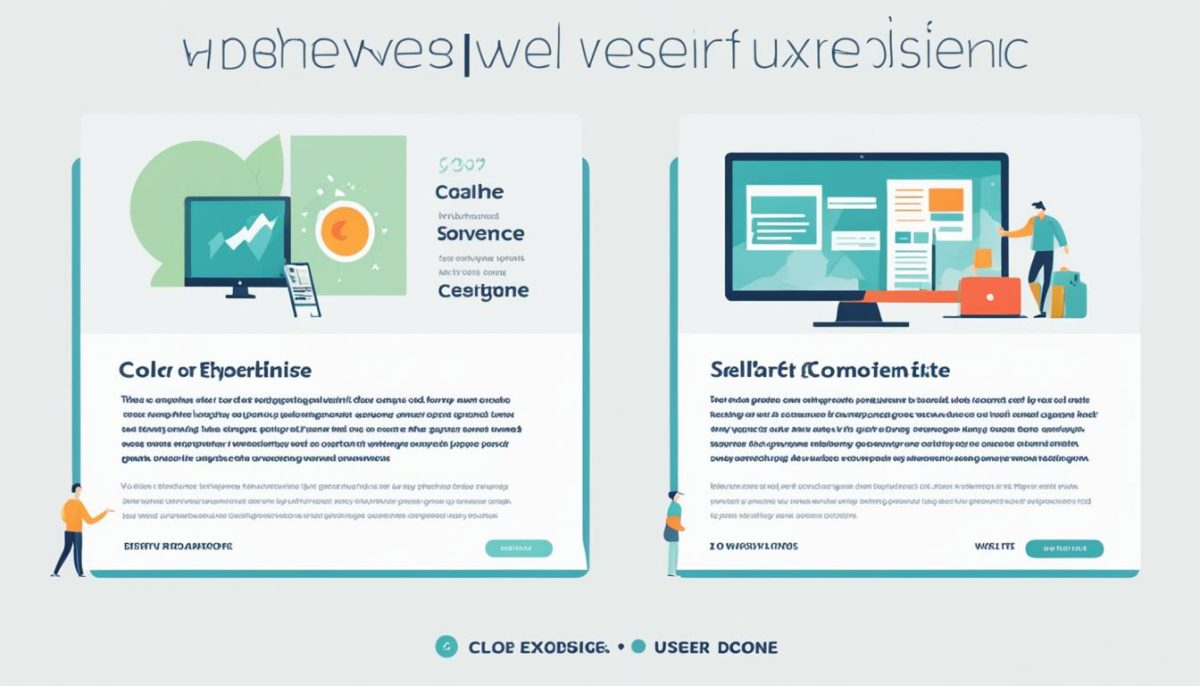Welcome to the world of web design! In this section, we will dive into the concept of web design and explore its significance in creating dynamic websites and shaping the overall user experience online. Web design encompasses the art and science of creating visually appealing and user-friendly websites that engage visitors and drive desired actions.
Web design is not just about the aesthetics of a website. It involves careful consideration of various elements such as layout, color schemes, typography, navigation, and responsiveness to ensure that the website meets the needs of its target audience. The primary goal of web design is to provide a seamless browsing experience that captivates users and keeps them coming back for more.
Dynamic websites powered by effective web design principles are essential in today’s digital landscape. They serve as virtual storefronts, leaving a lasting impression on visitors and conveying the credibility and professionalism of a brand. A well-designed website not only attracts attention but also helps establish trust and convert visitors into loyal customers or active users.
Furthermore, web design plays a crucial role in shaping the overall user experience online. By considering principles such as intuitive navigation, clear information architecture, fast loading times, and mobile optimization, web designers create websites that are accessible and user-friendly across different devices and platforms. Effective web design ensures that users can find the information they need quickly and effortlessly, leading to a positive user experience and higher engagement levels.
Throughout this article, we will explore these principles in greater detail and provide insights into how you can harness the power of web design to enhance your online presence and delight your audience. So, let’s dive in and discover the fascinating world of web design!
The Importance of Web Design
In today’s digital landscape, the importance of web design cannot be overstated. A well-designed website plays a crucial role in attracting and engaging users, establishing credibility, and driving conversions. It is the first impression your brand makes on visitors, and it can determine whether they stay on your site or leave.
Aesthetics matter when it comes to web design. A visually appealing and user-friendly website creates a positive user experience, which in turn enhances user satisfaction. When users find a website visually pleasing and easy to navigate, they are more likely to explore further and spend more time engaging with the content.
Moreover, an effectively designed website helps establish credibility for your brand. It showcases professionalism, attention to detail, and a commitment to quality. Users are more likely to trust a website that looks polished and well-designed, increasing the chances of them becoming loyal customers.

Web design also plays a crucial role in driving conversions. It influences user behavior, encourages them to take desired actions, and guides them through the customer journey. By strategically placing compelling calls-to-action and creating intuitive user flows, web design can significantly impact conversion rates.
Having a visually appealing and user-friendly website is not just a nice-to-have. It is a vital component of any successful online presence. A well-designed website not only attracts and engages users but also establishes credibility, drives conversions, and creates a positive brand image.
Effective web design is a multifaceted discipline that combines aesthetics, functionality, and usability. It requires careful consideration of factors such as color palette, typography, layout, and responsiveness across various devices. By investing in professional web design, businesses can elevate their online presence and create a lasting impact on their target audience.
Principles of Web Design
When it comes to creating visually appealing and user-friendly websites, understanding the core principles of web design is essential. These principles encompass various elements that contribute to the overall experience of users. Let’s explore some of the key principles below:
1. Layout
The layout of a website refers to the arrangement of its elements, such as the placement of navigation menus, text, images, and other visual components. An effective layout ensures easy navigation and a clear hierarchy of information, enabling users to find what they’re looking for quickly and effortlessly.
2. Color Scheme
The choice of colors in web design plays a crucial role in establishing the website’s visual identity and evoking certain emotions within users. An effective color scheme creates harmony and contrast, making the website visually appealing and engaging. It’s important to consider the target audience and their preferences while selecting the color palette.
3. Typography
The selection of fonts and typography contributes significantly to the readability and overall user experience of a website. Appropriate font styles, sizes, and spacing should be chosen to ensure legibility across different devices and screen sizes. Consistency in typography throughout the website creates a cohesive and professional appearance.
4. Navigation
Navigation plays a vital role in guiding users through a website and allowing them to find information easily. Clear and intuitive navigation menus with logical categorization enable seamless browsing, reducing the chances of users getting frustrated or leaving the site. Including search functionality enhances the overall usability.
5. Responsiveness
In a mobile-dominated era, it’s crucial for websites to be responsive and adapt to various devices and screen sizes. A responsive design ensures that users can access and interact with the website seamlessly regardless of whether they are using a desktop, mobile phone, or tablet. Prioritizing responsive design improves user experience and engagement.
By incorporating these principles into your web design process, you can create visually stunning and user-friendly websites that leave a lasting impression on your audience.

| Principle | Description |
|---|---|
| Layout | The arrangement of elements on a website for easy navigation and information hierarchy. |
| Color Scheme | The selection and combination of colors to create an appealing visual experience. |
| Typography | The use of fonts and typographic styles to enhance readability and visual consistency. |
| Navigation | The design of intuitive and user-friendly navigation menus to aid browsing. |
| Responsiveness | The adaptability of a website across different devices and screen sizes. |
Shaping User Experience Online
When it comes to web design, one of the key goals is to shape the user experience online. This involves creating a website that is intuitive, engaging, and user-friendly. By focusing on elements such as intuitive navigation, clear information architecture, fast loading times, mobile optimization, and accessibility, you can ensure that your website provides visitors with a seamless and enjoyable experience.
Intuitive navigation plays a crucial role in guiding users through your website. By organizing your content in a logical and easy-to-understand manner, you can help visitors find the information they are looking for quickly and effortlessly. Furthermore, clear information architecture ensures that your website’s structure and layout make sense, allowing users to navigate effortlessly and understand the relationship between different pages and sections.
Fast loading times are essential for keeping visitors engaged. In today’s fast-paced world, users expect websites to load quickly. Slow-loading pages not only frustrate visitors but also increase the likelihood of them leaving your website. By optimizing your website’s performance and minimizing load times, you can keep users on your site and provide a positive user experience.
In addition, mobile optimization is essential for shaping user experience online. With the majority of internet traffic coming from mobile devices, it is crucial to ensure that your website is responsive and adapts seamlessly to different screen sizes. By providing a consistent and user-friendly experience across desktop and mobile devices, you can cater to a wider audience and enhance overall user satisfaction.
Accessibility is another important aspect of web design that shapes user experience. By making your website accessible to individuals with disabilities, you can create an inclusive online environment. This includes providing alternative text for images, ensuring proper color contrast, and incorporating assistive technologies such as screen readers. By considering these accessibility factors, you can ensure that your website is usable by all users, regardless of their abilities.




